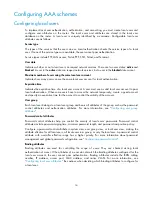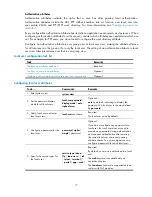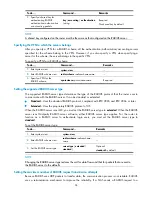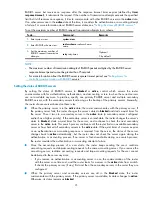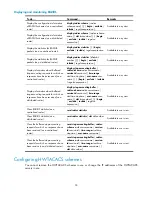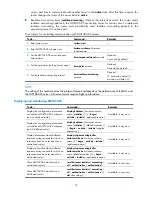
25
RADIUS server but receives no response after the response timeout timer expires (defined by
timer
response-timeout
), it retransmits the request. If the number of transmission attempts exceeds the specified
limit but it still receives no response, it tries to communicate with other RADIUS servers in the
active
state.
If no other servers are in the
active
state at the time, it considers the authentication or accounting attempt
a failure. For more information about RADIUS server states, see "
Setting the status of RADIUS servers
."
To set the maximum number of RADIUS request transmission attempts for a scheme:
To do…
Command…
Remarks
1.
Enter system view.
system-view
—
2.
Enter RADIUS scheme view.
radius scheme
radius-scheme-
name
—
3.
Set the maximum number of
RADIUS request transmission
attempts.
retry
retry-times
Optional
3 by default
NOTE:
•
The maximum number of transmission attempts of RADIUS packets multiplied by the RADIUS server
response timeout period cannot be greater than 75 seconds.
•
For more information about the RADIUS server response timeout period, see "
controlling communication with RADIUS
Setting the status of RADIUS servers
By setting the status of RADIUS servers to
blocked
or
active
, control which servers the router
communicates with for authentication, authorization, and accounting or turn to when the current servers
are not available anymore. In practice, specify one primary RADIUS server and multiple secondary
RADIUS servers, with the secondary servers functioning as the backup of the primary servers. Generally,
the router chooses servers based on these rules:
•
When the primary server is in the
active
state, the router communicates with the primary server. If
the primary server fails, the router changes the server's status to
blocked
and starts a quiet timer for
the server. Then it turns to a secondary server in the
active
state (a secondary server configured
earlier has a higher priority). If the secondary server is unreachable, the router changes the server's
status to
blocked
, starts a quiet timer for the server, and continues to check the next secondary
server in the
active
state. This search process continues until the router finds an available secondary
server or has checked all secondary servers in the
active
state. If the quiet timer of a server expires
or an authentication or accounting response is received from the server, the status of the server
changes back to
active
automatically, but the router does not check the server again during the
authentication or accounting process. If no server is found reachable during one search process,
the router considers the authentication or accounting attempt a failure.
•
Once the accounting process of a user starts, the router keeps sending the user's real-time
accounting requests and stop-accounting requests to the same accounting server. If you remove the
accounting server, real-time accounting requests and stop-accounting requests for the user cannot
be delivered to the server anymore.
{
If you remove an authentication or accounting server in use, the communication of the router
with the server soon times out, and the router looks for a server in the
active
state from scratch.
It checks the primary server (if any) first and then the secondary servers in the order they are
configured.
•
When the primary server and secondary servers are all in the
blocked
state, the router
communicates with the primary server. If the primary server is available, its status changes to
active
.
Otherwise, its status remains as
blocked
.






